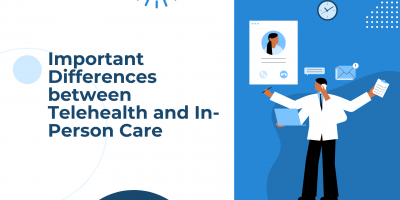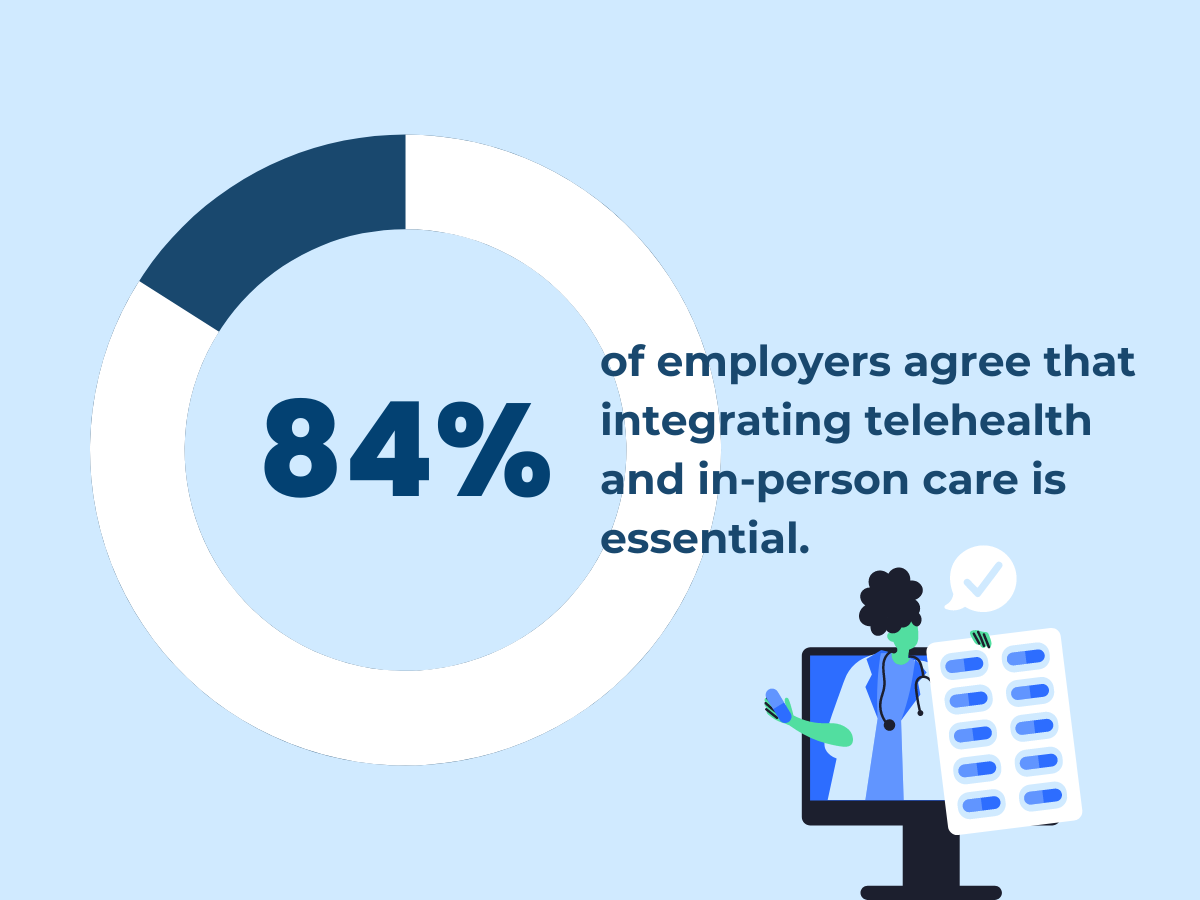
Important Differences between Telehealth and In-Person Care
Telehealth, which surged in use during the pandemic, has now established itself as a permanent fixture in healthcare. But how does it fare against in-person care?


MA, CCC-SLP, & Speech-Language Pathologist at MedStar Georgetown University Hospital
Few industries are evolving as quickly as healthcare.
Driven by consumer expectations, policy reforms, scientific breakthroughs, and technological advancements, healthcare innovations push for efficacy, convenience, and accessibility.
The last one, or how we access medical care, has introduced telehealth, a stark contrast to traditional, in-person care.
Also known as telemedicine or virtual health, this approach uses digital technologies to deliver remote medical services and patient support. As a result, its use spread rapidly during COVID-19, demonstrating significant potential by bridging the gaps left by the limitations of in-person care.
Nevertheless, how they administer patient care isn’t the only difference between telehealth and in-person care, nor does it indicate which approach is “better.”
Thus, this Shortlister article examines both concepts in more depth to answer the following questions:
In their 2022 Employer Health Benefits Survey, KFF revealed that telemedicine benefits in the workplace dramatically increased during lockdown.
Among businesses with 50 or more employees offering health benefits, 87% of small and 96% of large firms included telemedicine in their health plans.
Moreover, when asked about its future importance, employers thought that telehealth was “important” or “very important” for:
Recognizing its significance and growth post-pandemic, it begs the question: how did this transformation in healthcare unfold?
A quick look at the past reveals a substantial shift in not only how healthcare is delivered but also how it’s managed and experienced today.
Take, for example, medicine and medical practice.
Before the pharmaceutical industry, people used home remedies, mainly relying on a trial-and-error approach. Medical practice was largely reactionary, with limited diagnostic tools and treatments, which made many nonlife-threatening illnesses today a death sentence in the past.
In contrast, modern medicine, supported by technological advancement and scientific breakthroughs, introduced new medications, medical equipment and facilities, and life-saving treatments. In line with this, the number of practicing doctors surged by more than 400%, going from 219,900 in the 1950s to over 1.1 million as of January 2024 in the US alone.
Then came health information technology, big data, augmented reality, and artificial intelligence.
These pushed healthcare towards a more patient-centered and data-driven model, improving access to quality care. In addition, the COVID-19 pandemic accelerated the adoption of virtual care, including doctor-on-demand, remote patient monitoring, and virtual consultations.
Beyond addressing physical health concerns, these were crucial in supporting employees’ mental well-being during times of heightened stress and uncertainty. They expanded access, improved cost control, and ensured better health for the workforce, fortifying their importance as part of the modern healthcare system while challenging the traditional ways of accessing care.
Yet, despite all of this, the hands-on approach retained its significance.
As we set the ground for the telehealth vs. in-person care discussion, let’s first examine where these two fit within the healthcare system.

Right now, four different designs of healthcare systems are used worldwide, either separately or combined.
The US uses a mixed model of all four, creating a complex system where healthcare access and coverage depend on employment status, income level, age, and military service.
So, where do telehealth and in-person care fit into all of this?
While the four systems provide overarching frameworks for funding and organizing healthcare, telehealth, and in-person care operate within and alongside each model.
In fact, both approaches have their place in addressing patients’ diverse needs, ensuring access to quality care, and ultimately improving health outcomes.
However, they do the opposite, bringing distinct advantages and disadvantages for patients, healthcare providers, insurance companies, and employers.
Thus, understanding the important differences between telehealth and in-person care is crucial for navigating the evolving healthcare landscape and overcoming the challenges of delivering effective patient care.
Let’s start by defining these two concepts.
However, these definitions barely scratch the surface.
To gain insights from firsthand experience with both approaches, we spoke with Angela Morrell, MA, CCC-SLP, and speech-language pathologist at MedStar Georgetown University Hospital.
When asked what the most important differences between telehealth and in-person care were in her field, Morrell pointed out the following:
“Telehealth offers wider reach, allowing me to see patients beyond our facility’s location. However, it limits my ability to evaluate patients, making it difficult to assess cognitive function, communication skills, or swallowing problems.
In-person visits are better suited for patients with cognitive or vision issues or requiring specialized equipment or techniques.
Overall, quality care can be delivered through both methods, but the best option depends on the situation.”
The contrasts become even more pronounced as we broaden our scope to include factors like cost, infrastructure, or data privacy.
Below, we’ve summarized the most significant differences between telehealth and in-person care.

Telehealth: Accessibility is the main reason virtual health surged during the pandemic. Since then, it has become the go-to approach for patients to consult with healthcare providers remotely. It is especially beneficial for those in rural or remote areas, reducing the need for travel, saving time, and improving work-life balance by providing healthcare services from the comfort of their homes.
“Telehealth is optimal for patients with mobility challenges and transportation difficulties, for those who can access the technology independently, or those with a caregiver who can assist with the technology. It offers convenience and saves time compared to traditional office visits,” adds Angela Morrell.
In fact, statistics show that the wait time for a telemedicine appointment and the visit lasted an average of 20 minutes.
In-Person Care: Unlike telehealth, scheduling an in-person appointment takes an average of 18.4 days, while the visit lasts 121 minutes.
Moreover, in-person care requires patients to travel to healthcare facilities, which can be challenging for those without reliable transportation or living in remote areas. It also involves more time commitment and can be difficult for individuals with mobility issues or disabilities.

Telehealth: This option is more affordable when comparing telehealth costs vs. in-person medical expenses. In fact, according to the AMA’s Telehealth Survey Report, 44% of clinicians agree that telehealth decreased care costs. Several factors weigh in on this, like excluding travel expenses or taking days off work.
Moreover, studies show telemedicine visits often have lower copays, making employer-sponsored telehealth 23% less expensive than in-person care.
In-Person Care: In-person care is more expensive because of all the factors that telehealth circumvents, such as travel expenses and work absenteeism. Additionally, the operational costs of maintaining physical healthcare facilities can contribute to higher overall costs for patients and providers.
Telehealth: Remote medical care may be suitable for routine follow-ups, monitoring chronic conditions like diabetes or hypertension, health education, and prescription management. However, it falls short in other areas.
For example, comparing online therapy vs. in-person therapy, we find that telehealth offers convenience and flexibility. Yet, it may lack the personal connection and nonverbal cues essential for effective treatment, potentially impacting the quality of care. Furthermore, telehealth limits physical examinations and diagnostic tests, affecting the accuracy of diagnoses and treatment plans.
The quality of care may also depend on factors such as the patient’s access to technology, internet connectivity, and the healthcare provider’s experience delivering the services.
In-Person Care: This aspect of traditional health care cannot be replaced, at least not for the foreseeable future. In-person care often provides a more comprehensive assessment and treatment experience, from physical examinations to diagnostic tests and in-person procedures. As a result, this leads to more accurate diagnoses and tailored treatment plans.
In-person visits also allow for direct observation of non-verbal cues and a more personal connection between patients and providers, enhancing the overall quality of care.
Telehealth: Healthcare has always relied on a hands-on approach, so switching to the virtual nature of telehealth appointments can create barriers to effective communication. Additionally, the absence of physical presence may impact the patient’s perception of the provider’s attentiveness and empathy.
In-Person Care: Conversely, the traditional approach facilitates direct, face-to-face interactions between patients and providers, allowing for more personal connections. Physical presence, including gestures, body language, and eye contact, can benefit patients, enhancing trust and rapport.

Telehealth: Its heavy reliance on technology, internet connectivity, compatible devices, and secure communication platforms makes the telehealth infrastructure somewhat challenging and unstable. Additionally, telehealth services may require investments in training and support for both providers and patients to utilize the technology effectively.
In-Person Care: In-person care requires physical infrastructure, such as buildings and medical equipment, to support face-to-face consultations and treatments. While technology aids in electronic health records and medical imaging, it plays a lesser role than telehealth.
Telehealth: Finally, as we adapt to virtual healthcare, patient privacy and security emerge as challenges. Temporary changes to telehealth policies have occurred at the federal and state levels. However, despite high demand, making them permanent has been slow.
A systematic review of the risk factors indicates a need for a comprehensive approach that involves creating guidelines and policies to address technology, digital skills, and accessibility and minimize risks to privacy and security.
In-Person Care: In-person care traditionally offers greater control over privacy and security, with confidential discussions conducted within private healthcare settings. However, healthcare facilities must adhere to privacy regulations when handling paper-based records and electronic health information to prevent breaches and unauthorized access.
Embracing digital healthcare technologies is not only about telehealth; it also encompasses software integration, such as EMR integration software, which streamlines administrative workflows and improves patient care. Integrations like these harmonize health records and practice management systems, making both telehealth and in-person care more efficient and effective.
Based on the important differences between telehealth and in-person care, we summarize their main advantages and disadvantages below.
|
|
TELEHEALTH |
IN-PERSON CARE |
|
PROS |
|
|
|
|
|
|
|
CONS |
|
|
Technology is poised to shape the future of healthcare.
Innovations like AI and personalized medicine are at the forefront, making healthcare more cost-efficient, accessible, and tailored to individual needs.
Almost all large employers currently offer virtual care services, a testament to their growing significance. However, there is more to virtual care than telehealth.
According to Mercer’s National Survey of Employer-Sponsored Health Plans, one-fourth of employees offered targeted virtual health solutions, while 28% provided a virtual behavioral healthcare network.
Moreover, AI-powered triage programs, which recommend care based on symptoms, are starting to gain popularity. However, right now, only two percent of employers offer them, but an additional five percent are considering them.
Employees receiving care are using these services for affordable routine consultations, online therapy, and managing chronic conditions. Not only this, but the integration of technology also empowers individual experiences, providing people with more control and convenience in managing their time and health.
As these advancements continue to evolve, the healthcare landscape will increasingly focus on delivering comprehensive, patient-centered care that adapts to the needs of a diverse population.
Radish Health
Radish Health's expertise, emphasis on personalized care, comprehensive services, and commitment to patient satisfaction make it an excellent choice for a top telehealth solution. Visit Website

Identifying what the important differences between telehealth and in-person care are provides a clear and affirmative answer to this question.
Telehealth will never fully replace in-person care, nor was that ever its goal. Instead, it evolved to complement traditional healthcare by making it more accessible, convenient, and affordable.
In fact, a Business Group of Health report reveals that 74% of employers believe virtual health will impact how care is delivered in the future. Another 57% plan to add more of these solutions to their employee benefits.
However, 84% of employers agree that integrating telehealth and in-person care is essential.
As we move towards technological advancements never seen before, it’s safe to assume that both will undergo significant changes and upgrades. Yet, they will continue to complement one another, strengthening the idea of a hybrid healthcare system.
Disclosure: Some of the products featured in this blog post may come from our partners who compensate us. This might influence the selection of products we feature and their placement and presentation on the page. However, it does not impact our evaluations; our opinions are our own. The information provided in this post is for general informational purposes only.
Content Writer at Shortlister
Browse our curated list of vendors to find the best solution for your needs.
Subscribe to our newsletter for the latest trends, expert tips, and workplace insights!

Telehealth, which surged in use during the pandemic, has now established itself as a permanent fixture in healthcare. But how does it fare against in-person care?

What compels someone to travel halfway around the world for a hip replacement or cancer therapy?

Imagine knowing the exact cost of your healthcare services upfront. The Healthcare Price Transparency Act promises just that.

The effects of cancer and cancer treatment on a person can range from mildly debilitating to severely incapacitating. But would that qualify them as disabled, and is cancer considered a disability under the ADA?
Used by most of the top employee benefits consultants in the US, Shortlister is where you can find, research and select HR and benefits vendors for your clients.
Shortlister helps you reach your ideal prospects. Claim your free account to control your message and receive employer, consultant and health plan leads.